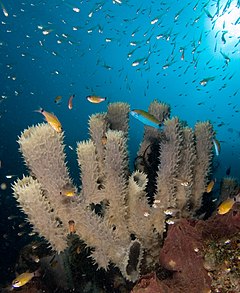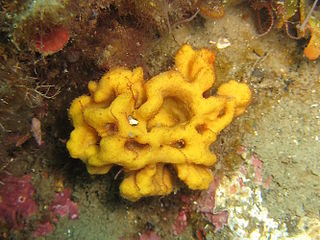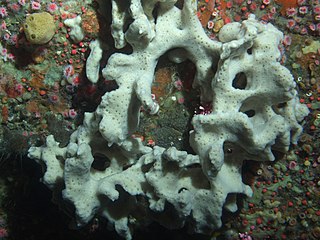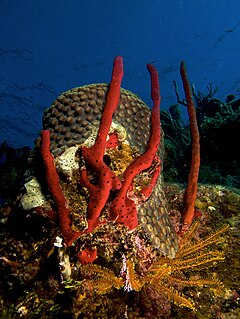| Neopetrosia | |
|---|---|
| Scientific classification | |
| Kingdom: | Animalia |
| Phylum: | Porifera |
| Class: | Demospongiae |
| Order: | Haplosclerida |
| Family: | Petrosiidae |
| Genus: | Neopetrosia de Laubenfels, 1932 |
| Type species | |
| Haliclona longleyi de Laubenfels, 1932 | |
| Species | |
See text | |
| Synonyms [1] | |
| |
Neopetrosia is a genus of marine petrosiid sponges. It was first established by the American spongiologist Max Walker de Laubenfels in 1932. It contains these 27 species: [1]
A genus is a taxonomic rank used in the biological classification of living and fossil organisms, as well as viruses, in biology. In the hierarchy of biological classification, genus comes above species and below family. In binomial nomenclature, the genus name forms the first part of the binomial species name for each species within the genus.

Marine habitats are habitats that support marine life. Marine life depends in some way on the saltwater that is in the sea. A habitat is an ecological or environmental area inhabited by one or more living species. The marine environment supports many kinds of these habitats.

Petrosiidae is a family of sponges containing the following four genera:
- Neopetrosia carbonaria (Lamarck, 1814)
- Neopetrosia chaliniformis (Thiele, 1899)
- Neopetrosia compacta (Ridley & Dendy, 1886)
- Neopetrosia contignata (Thiele, 1899)
- Neopetrosia cristata Vicente, Ríos, Zea & Toonen, 2019
- Neopetrosia cylindrica (Lamarck, 1815)
- Neopetrosia delicatula (Dendy, 1905)
- Neopetrosia dendrocrevacea Vicente, Ríos, Zea & Toonen, 2019
- Neopetrosia densissima (Wilson, 1904)
- Neopetrosia dominicana (Pulitzer-Finali, 1986)
- Neopetrosia dutchi Van Soest, Meesters & Becking, 2014
- Neopetrosia eurystomata Van Soest, Meesters & Becking, 2014
- Neopetrosia granulosa (Wilson, 1925)
- Neopetrosia halichondrioides Dendy, 1905
- Neopetrosia massa (Ridley & Dendy, 1886)
- Neopetrosia ovata Van Soest, Meesters & Becking, 2014
- Neopetrosia perforata (Lévi, 1959)
- Neopetrosia problematica (de Laubenfels, 1930)
- Neopetrosia proxima (Duchassaing & Michelotti, 1864)
- Neopetrosia rava (Thiele, 1899)
- Neopetrosia retiderma (Dendy, 1922)
- Neopetrosia rosariensis (Zea & Rützler, 1983)
- Neopetrosia sapra (de Laubenfels, 1954)
- Neopetrosia seriata (Hentschel, 1912)
- Neopetrosia sigmafera Vicente, Ríos, Zea & Toonen, 2019
- Neopetrosia similis (Ridley & Dendy, 1886)
- Neopetrosia subtriangularis (Duchassaing, 1850)
- Neopetrosia sulcata Santos, Sandes, Cabral & Pinheiro, 2016
- Neopetrosia tenera (Carter, 1887)
- Neopetrosia truncata (Ridley & Dendy, 1886)
- Neopetrosia tuberosa (Dendy, 1922)
- Neopetrosia vanilla (de Laubenfels, 1930)
- Neopetrosia zumi (Ristau, 1978)
Neopetrosia proxima is a species of marine petrosiid sponge native to the tropical and subtropical waters of the western Atlantic Ocean.
Neopetrosia subtriangularis is a species of marine petrosiid sponges native to the waters off Florida and the Caribbean Sea. They superficially resemble staghorn corals.








